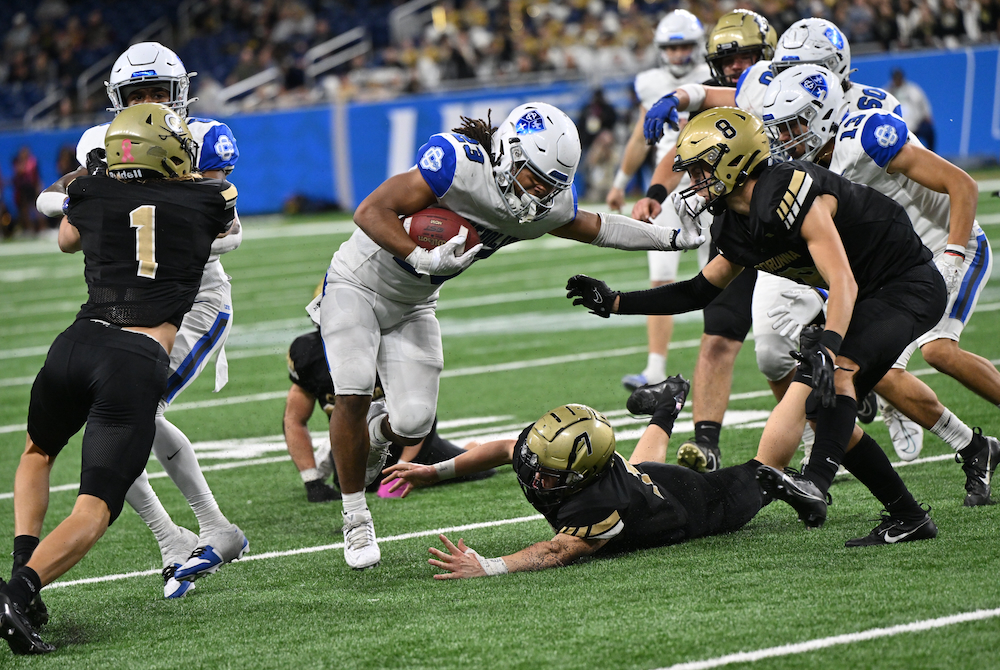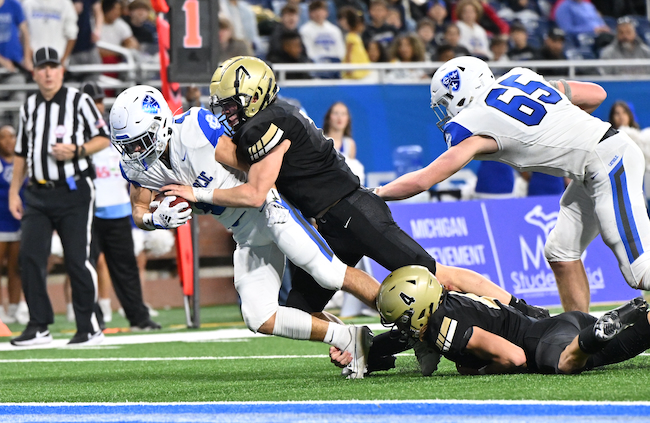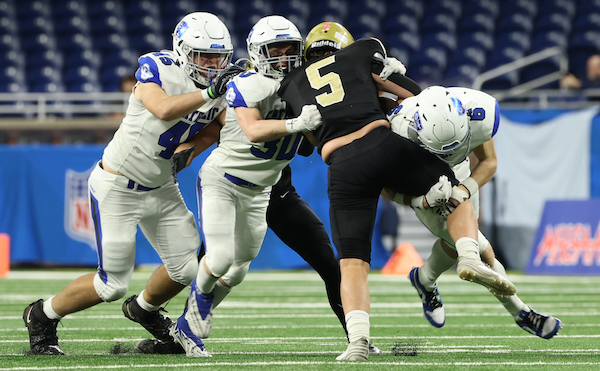
Inside Selection Sunday: Mapnalysis '13
October 28, 2013
By Geoff Kimmerly
Second Half editor
At the end of the day – Sunday, in this case – the 2013 MHSAA football playoff field was determined based on a set of numbers we began working with long before the first kickoff of this season.
So to kick off our discussion of how some of the 2013 playoff-selection decisions were made, here are a few numbers that might boggle the mind – or at least surprise:
- A total of 3,111 high school results were used in determining this season’s field – 2,978 for 11-player and 133 for 8-player games.
- We inputted and then followed the schedules for 623 MHSAA teams.
- We also inputted and followed weekly the schedules for 50 teams from surrounding states and Ontario that played at least one game against one of our MHSAA schools.
- We worked through complicated maneuverings made necessary by seven teams playing a mix of 11 and 8-player games, plus two more teams that played a mix of varsity and junior varsity opponents.
- And by Sunday morning we ended up with a few more numeric rarities: only 225 automatic qualifiers, the fewest since the current playoff system was introduced in 1999, and also an uneven number of at-large bids from our four classes because only six Class D teams reached the number of victories needed to be considered. (This was balanced by taking more at-large qualifiers from Classes A, B and C.)
And that was just the start of one of our most exciting days of the school year.
Following are more details. First, I explain some of the history of the MHSAA playoffs – I’ve lifted this in part from our 2012 report, so skip ahead if you’ve already got that down. Next, I touch on five themes that emerged as we built the brackets for this season’s tournament.
The process
Our past: The MHSAA playoff structure – with 256 teams in eight divisions, and six wins equaling an automatic berth (or five wins for teams playing eight or fewer games) – debuted in 1999, as mentioned above. An 8-player tournament was added in 2011, resulting in nine champions total when November is done.
That’s a long way from our start. The first playoffs were conducted in 1975 with four champions. Four more football classes were added in 1990 for a total of eight champions each fall. Through 1998, only 128 teams made the postseason, based on their playoff point averages within regions (four for each class) that were drawn before the beginning of the season. The drawing of Districts and Regions after the end of the regular season did not begin until the most recent playoff expansion.
In early years of the current process (or until the middle of the last decade), lines were drawn by hand. Dots representing qualifying schools were pasted on maps, one map for each division, and those maps were then covered by plastic sheets. Districts and Regionals literally were drawn with dry-erase markers.
Our present: After a late Saturday night tracking scores, we file in as the sun rises Sunday morning for a final round of gathering results we may still need (which can include making a few early a.m. calls to athletic directors). Then comes re-checking and triple-checking of enrollments, what schools played in co-ops, some records and more before the numbers are crunched and the fields are set.
Those 256 11-player teams are then split into eight equal divisions based on enrollment, and their locations are marked on digital maps that are projected on wall-size screens and then discussed by nearly half of the MHSAA staff plus a representative from the Michigan High School Football Coaches Association. Only the locations themselves are marked (by yellow dots) – not records, playoff point averages or names of the schools or towns. In fact, mentions of those are strictly prohibited. Records and playoff points are not part of the criteria. Matchups, rivalries, previous playoff pairings, etc. also DO NOT come into play. The same process is followed for organizing the 8-player bracket.
Observations and answers: 2013
This doesn’t happen overnight: Preparation for selecting the MHSAA playoff field begins long before the first kickoff of fall, much less the first practice. We load schedules for all 600-plus varsity teams during the summer, and many schedules remain fluid right up until the first Friday of the season – and this fall, a few weren’t settled until Week 2 or 3.
This summer as in some past we also worked through schools closing (Inkster, Saginaw Buena Vista, Detroit Northwestern, Flint Northern), and others deciding in mid-July and early August they would not field teams because of a lack of players.
Sometimes we have to take odd paths to find scores for these games. The last 11-player score to be added to our data this regular season came in as a result of tweeting the sports anchor of a Wheeling, W.Va., television station. Our last 8-player score came in via email from a Wisconsin athletic director at 10:30 Saturday night. Thankfully, we get plenty of assistance from some of our friends in the field, who keep an eye on the data and alert us when something appears missing or incorrect.
Win and advance: This season’s list of 5-4 teams includes a number of heavy hitters that did not receive at-large bids – East Grand Rapids, Utica Eisenhower, Orchard Lake St. Mary’s and Flint Powers Catholic to name a few. All were solid teams and played strong competition. All missing the playoffs likely raised some eyebrows.
But we have to take a look at this from a statewide view. There admittedly can be some argument about what schools qualified for the 226-256 spots in the field – but the important part is that 225 qualified because they all met the minimum win requirement. A playoff is simply that – it decides a champion based on teams winning. For some it’s harder to pile wins, of course, because they play in tough leagues. But the winners of those leagues are in the field – and surely will credit that tough road with getting them prepared to now play the state’s best.
Geography rules: This long has been rule number one for drawing MHSAA brackets in any sport, and is a repeat as well for those who have read this report the last two Octobers. Travel distance and ease DO come into play. Jumping on a major highway clearly is easier than driving across county-wide back roads, and that’s taken into consideration.
Also, remember there’s only one Mackinac Bridge and hence only one way to cross between peninsulas – and boats are not considered a possible form of transportation. When opponents from both peninsulas will be in the same District, distance to the bridge is far more important than as the crow flies.
The best example of this comes this season in Division 5. Grayling clearly is east of both Kingsley and Kalkaska – but also sits on I-75, while those two do not. So while those more western teams are geographically closer to Houghton, Menominee and Kingsford from the Upper Peninsula, we instead paired the three U.P. teams with Grayling because being on a main highway made for a shorter trip. The trip to Grayling for any of those U.P. teams would be 36 miles shorter to Grayling than Kingsley and 13 miles shorter to Grayling than Kalkaska.
Sometimes it’s where the points aren’t: Sure, it would be best-case scenario to have perfect sets of eight dots split into four quadrants from Calumet to Bedford. But generally that doesn’t occur. “Dots determine the map” is a common phrase heard here during this selection process, but that works the other way as well. If there are no qualifiers in a division from a specific area of the state – see Division 1, with none south of Holland or west of the greater Lansing area – there’s no choice but to create the unusual Regional Final possibility of Traverse City West vs. Brighton. Brighton is simply closer to the west side of the state than our other options.
Border to border vs. coast to coast: Should Regions be grouped north to south or east to west? There isn't a right or wrong answer – it just depends on that set of dots.
Whenever we have Upper Peninsula teams in a division, they’ll be grouped with those from the northernmost points of the Lower Peninsula for a District. The next northernmost schools will be grouped into a District, and together those eight will form a Region.
But the tough decision comes with the other six Districts. Look at this season’s Division 5 map: Six Districts are grouped south of U.S. 10 with three near or west of U.S. 127 and three east of that highway, which runs through the center of the Lower Peninsula. We grouped the two southwestern Districts into a Region and the two southeastern Districts into a Region – leaving a final Region that stretches from Muskegon on Lake Michigan to Almont, about 35 miles west of Lake Huron.
That’s a haul. But it’s also the best of our possible compromises. We could’ve instead paired regions that would’ve stretched from Hopkins to Monroe – only 19 fewer miles in distance than Muskegon Oakridge to Almont, but a scenario that could’ve created travel increases for a number of additional teams. Another option included a possible trip from Detroit University Prep to Freeland, which also would take more than two hours.
Bottom line – it’s been written here before – we pour all we have into this process, asking questions often more than once until we come up with a consensus. We do appreciate the arguments that arise once brackets are released to the public: The discussions are proof of how much players, coaches and fans care – and often show us new ways we can look at a system that’s now 15 years old.
But we must remember that the good news is the tournament is still set up to reward nine champions over the next five weeks, and five schools – Auburn Hills Oakland Christian, Coldwater, Detroit Allen, Eaton Rapids and Muskegon Mona Shores – will be competing for those titles for the first time.
It’s not so much how the tournament starts as how it ends. And we’re preparing for nine more memorable conclusions.
PHOTO: Each collection of grouped dots is a District on this season's Division 3 playoff map.

Driven by 2022 Semifinal Loss, GR Catholic Central Reclaims Top Spot in D5
By
Tom Kendra
Special for MHSAA.com
November 26, 2023
DETROIT – Corunna coach Steve Herrick’s final words at the postgame press conference pretty much summed up his team’s struggles in Sunday’s Division 5 title game.
“It’s tough to prepare for a team like Grand Rapids Catholic Central,” explained Herrick, whose school was playing at the Finals for the first time.
“We took care of preparing for their receivers and linemen pretty well, but No. 7 and No. 23 were hard for us to mimic at practice. We don’t have anyone like them.”
With that, Herrick and his players exited the interview area just as GRCC’s No. 7, senior quarterback Connor Wolf, and No. 23, senior running back Kellen Russell-Dixon, squeezed past them, the stars of the Cougars’ 21-7 victory.
Wolf scored all three touchdowns for GRCC, on a pair of 1-yard runs in the second quarter and a 10-yard burst in the fourth quarter, as the Cougars won their eighth Finals title in 10 championship game appearances.
Russell-Dixon didn’t get in the end zone, but was the game’s leading rusher with 20 carries for 133 yards, to go with two receptions for 19 yards.
Both senior leaders said it was a devastating loss to eventual champion Gladwin in last year’s Semifinal, 28-21, which fueled the team’s desire to get back to the mountaintop.
 “That loss last year showed us we still had so much work to do to be our best,” said Wolf, who completed 10-of-22 passes for 82 yards and rushed 11 times for 78 yards and the three scores.
“That loss last year showed us we still had so much work to do to be our best,” said Wolf, who completed 10-of-22 passes for 82 yards and rushed 11 times for 78 yards and the three scores.
Added Russell-Dixon: “I remember watching the Division 5 championship game on TV last year, and just thinking about how we had it in our hands and we weren’t focused and we let it slip away.”
GRCC, which finished 13-1 after a season-opening home loss to powerhouse Chicago Loyola, was focused and prepared Sunday, mixing up the pass and run exquisitely to take a 14-0 halftime lead.
Corunna, also 13-1, averaged more than 41 points per game coming in, but struggled in the first half against the experienced Cougars.
“I felt like they were more physical than us,” said Corunna senior quarterback and defensive back Wyatt Bower. “I felt like all year we didn’t get the respect we deserved, but we battled those guys in the second half.”
The Cavaliers did exactly what they had to do coming out of halftime, taking the third-quarter kickoff and marching 67 yards in 14 plays, capped with a 7-yard burst up the middle by Bower on a 4th-and-goal play, that cut the lead to 14-7.
That score brought a sizable group of black-and-gold clad fans from Corunna, a community of about 4,000 people between Lansing and Flint, to its feet.
However, that turned out to be as close as Corunna would get against a quick and hard-hitting GRCC defense.
The Cougars added an insurance touchdown in the fourth quarter after a short punt gave them the ball at Corunna’s 35-yard line. Eight plays later (six of those runs by Russell-Dixon), Wolf took it the final 10 yards to ice the win.
“It never gets old,” explained 12th-year GRCC coach Todd Kolster, who has guided the Cougars to titles in four of the past five years and six of the last eight. “One of the things I cherish the most from the Finals is the team photo we take down on the field. I never get in those photos. Then when I get a moment, I can look at all those kids who worked so hard and gave so much.”
 GRCC, which held a 315-239 edge in total yardage, made Corunna work for every yard Sunday.
GRCC, which held a 315-239 edge in total yardage, made Corunna work for every yard Sunday.
Senior linebacker Austin Baxter (6-foot, 185 pounds) set the tone for the Cougars’ defense with eight tackles. Adam Whalen and Derek Weiss made six tackles apiece, and Mill Coleman III added five tackles and the game-clinching interception in the end zone with five minutes remaining.
Wolf said family ties drive the Cougars’ year-in, year-out success – the connections to both his football brothers and his actual biological family.
“My dad, grandparents, uncles, they all went to Catholic Central,” said Wolf, a 6-3 dual threat QB who passed for more than 2,500 yards with 23 TD passes and only two interceptions. “This means a lot to all of us, to continue the Cougar tradition.”
Corunna, which was led all season by Wyatt Bower and his identical twin brother, Tarick (one of his favorite receiving targets), got a strong final game from senior fullback/linebacker Jaden Edington, who made a game-high 10 tackles and rushed 14 times for 70 yards.
The Bower twins, sprinters who helped Corunna win the Lower Peninsula Division 2 Track & Field championship last spring, finished their football careers in style. Wyatt completed 6-of-16 passes for 123 yards, no touchdowns and one interception, while making eight tackles on defense. Tarick made two catches for 69 yards.
Kaden Cowdrey and Dayne Zeeman each made eight tackles for the Cavaliers.
PHOTOS (Top) Grand Rapids Catholic Central’s Kellen Russell-Dixon (23) prepares for contact with Corunna’s Kaden Cowdrey (8) during Sunday’s Division 5 Final. (Middle) The Cavaliers’ Wyatt Bower (4) and Dayne Zeeman work to bring down GRCC’s Lucas Thelen short of the goal line. (Below) Brayden Sweeney (6) and Derek Weiss (30) wrap up Corunna’s Parker Isham. (Photos by Hockey Weekly Action Photos.)

